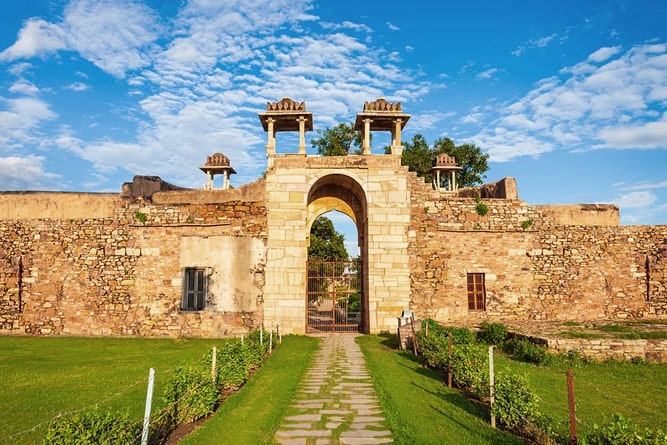Chittorgarh Fort
Fort, 119 km from Udaipur
should-see attraction
Opening hours: dawn-dusk
Address: Chittor Fort Rd, Chittorgarh, Rajasthan
Ticket price: Indian/foreigner ₹40/600
Visit duration: People typically spend up to 1.5 hours here
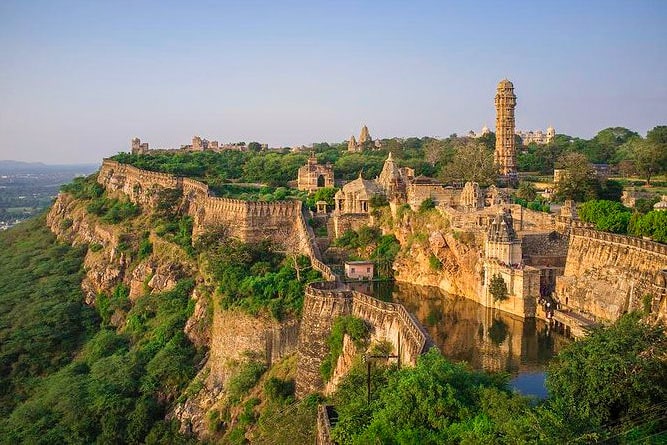
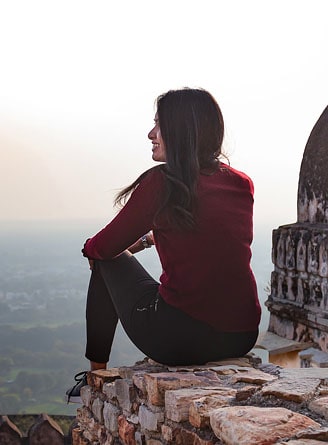
About Chittorgarh Fort
The Chittorgarh Fort was the capital of the Mewar kingdom. It is located between Udaipur and Bundi. The fort is built on a hill at an elevation of 590 feet harbouring all the attractions of the city while the rest of the plateau is deserted.
The Chittorgarh Fort showcases in every nook and corner, not just the valour of Rajput warriors but also the courage of the Rajput women. The unbending spirit of women echoes in every corner of the fort. The Chittorgarh Fort upholds the pride of the people of the state.
The valley is drained by the Beach River and is divided into three parts, the forest, the historical edifices and the municipality.
In 2013 the Chittorgarh Fort was declared a UNESCO World Heritage Site, under the category of the Hill Forts of Rajasthan.
History of Chittorgarh Fort
Chittorgarh was initially called Chitrakut which was built by a regional Mori Rajput, ruler Chitrangada Mori. The fort witnessed the struggle of the Rajput clan and their relentless spirit to face crucial times as a united front. The documented history of the fort begins with Bappa Rawal. He was a Guhila ruler of the Rajput dynasty who had control of the fort during the first half of the 8th century.
In 1303, the Delhi Sultanate ruler Alauddin Khalji attacked Chittorgarh during the reign of the Guhila king, Ratnasimha. According to the Sultan's courtier Amir Khusrow, Alauddin succeeded to capture Chittorgarh Fort after an eight-month-long siege. Alauddin designated Chittorgarh to his young son Khidr Khan and the fort was renamed Khizrabad after the prince, but the administration was handled by a slave, Malik Shahin.
The fort witnessed its first Jauhar, a sacrifice made by all women and young girls where they jump into a massive pyre to save their honour when their kind loses.
The Rajputs compelled Khizr Khan to entrust his power to the Sonigra chief, Maldeva by 1311. Hammir Singh, a 14th-century Rajput ruler usurped the fort from Maldeva after seven years. The dynasty prospered under Hammir's rule and the clan became the renowned Sisodia clan of the Rajput dynasty before he died in 1378. The famous ruler Rana Kumbha was his offspring that ascended the throne in 1433.
Rana Khumba's diligent efforts turn the Mewar into a formidable kingdom. After that, his brother, Rana Raimal accepted the throne in 1473. His youngest son, Sangram Singh, popularly known as Rana Sanga inherited the throne in May 1509. The kingdom reached its zenith in power and prosperity.
Bahadur Shah ascended as the Sultan of Gujarat besieged the Chittorgarh Fort in 1535. Another Jauhar was committed during his reign by 13,000 Rajput women while 3,200 Rajput warriors defended the fort and died in the battle.
33 years later during Rana Uday Singh II's rule, the fort was seized for the final time by the Mughal Emperor Akbar to gain access to the Gujarati ports and establish a trade route. The attack led to another Jauhar and the Rajputs lost their claim on the fort until the rule of Jahangir when he signed a treaty with Amar Singh, a Rajput ruler and gave back the fort in 1616.
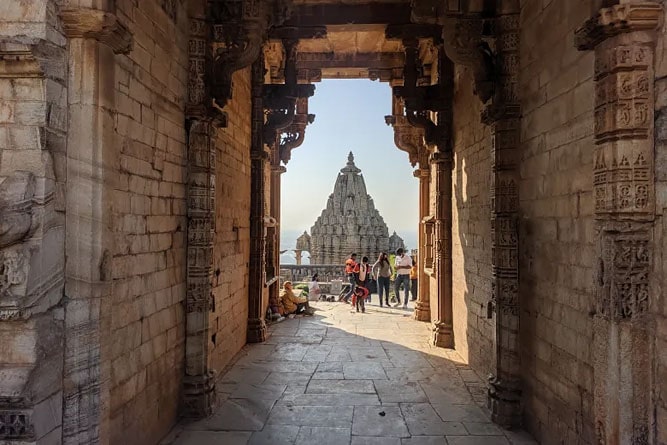
Architecture of Chittorgarh Fort
The Chittorgarh Fort is the largest fort in Asia that is spread across 700 acres of land. The perimeter of the fort does not follow a uniform shape. The circumference of the fort is defended by a 13 km long wall. The fort is difficult to penetrate due to the presence of a 45-degree hill slope. The walls are 4.5 metres thick and are built from stone masonry and lime mortar.
The fort complex comprises four palaces, nineteen temples, twenty water bodies, four memorials and several victory towers. A long and ascent winded road guides you to the limestone bridge which rises over the Gambhiri River. The path is long enough to harbour seven gates before arriving at the main premise.
The Paidal Pol is the first gate located at the base of the slope which is followed by Bhairon Pol, Hanuman Pol, Ganesh Pol, Jorla Pol, Laxman Pol and finally the Ram Pol announces your entrance into the fort.
The defence of the fort is the strength of dividing the complex into two parts. The initial entrance was built in the 5th century and it remained secured till the 12th century. The second and most significant reinforcement was developed in the 15th century. The seven gates form the second and primary fortification of the fort. The gateways are flanked by towers.
The fort accommodates numerous historical buildings, Ratan Singh Palace, and temples of the Kshemkari Temple of 825–850, the 15th–16th-century Adbuthnath Temple, Jain temple, Sattaees Devari along with Shrinagar Chauri of 1448 and Sat Bis Devri from the mid-15th century, among which some are in ruins while others are renovated.
Padmini’s Palace, a popular attraction among tourists, used to be the residence of Rani Padmini. It is a white three-storied building surrounded by a water moat and is located in the southern region of the fort. The palace initiated the architectural concept of the Jal Mahal. The roof of the palace is decorated by Chhatris or canopies. The palace was later repaired by Maharana Sajjan Singh.
Rana Kumbha Mahal, now in ruins, used to be the palace of Rana Kumbha. The renowned saint-poetess, Mirabai, also resided in this palace. It is built from plastered stone and is located near the entrance of the fort that once consisted of a temple of Lord Shiva and stables to house elephants and horses.
Kalika Mata Temple dates back to the 8th century was initially a sun temple, dedicated to the Sun God which was later remodified in the 14th century and dedicated to Goddess Kali.
The Tulja Bhavani Temple is located on the western side of the fort. The temple was dedicated to Goddess Tuljia Bhavani by Banvir, a 16th-century Mewarruler.
The Kumbha Shyam Temple is a pyramid-shaped temple dedicated to Mirabai, a mystic saint-poet. She was a passionate devotee of Lord Krishna. Rana Khumba made the temple in 1448 in Indo-Aryan style crowned with tall shikharas. The temple is also known as the Varhara Temple and is settled close to the Vijay Stambha. The carved panels describe Mewar life in the 15th century.
Kirti Stambh is dedicated to the first Jain Tirthankar, Adinath, by a Bagherwal Jain merchant, Jijaji Rathod. The 12th-century tower of fame is 72 feet tall with the plinth being 30 feet. It has 54 narrow steps stairs collecting to a six-storey tower with a 12 columns top pavilion being a later addition. The tower is ornamented with engraved illustrations of naked figures of various Tirthankaras, signifying the monument of the Digambara or sky-clad order.
Vijay Stambha (1433–1468) or the Jaya Stambha was built by Rana Kumbha as a symbol of victory against the sultan of Malwa, Mahumad Shah I Khalji. It is 122 feet tall and consists of 157 steps and eight storeys. The dome was a later addition which was damaged by lightning in the 19th century.
Gaumukh Reservoir is situated at the edge of the hill and close to Samidheshvara Temple. It was the primary source of water for the fort during critical times. The tank is filled with water from a spring through a carved cow’s mouth on the cliffside.
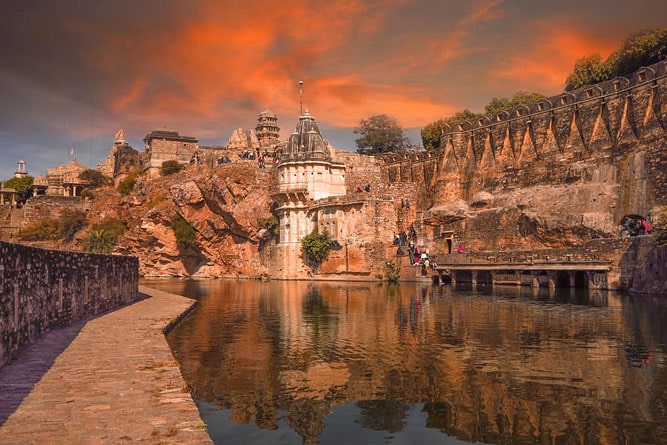
Entry fee and timings
The Chittorgarh Fort is open every day from 9:00 am to 6:00 pm. Indians have to purchase entry tickets that cost ₹40 while foreigners have to pay ₹600 as an entry fee.
Facts and tips about Chittorgarh Fort
- The Mahasati area is located southwest of the victory tower. This was the royal cremation ground where 13,000 women committed Jauhar, a ritual of mass suicide by immolation in 1535.
- The bronze gates of the Padmini Palace were taken away to ornament the Agra Fort during the rule of Akbar.
- A sound-and-light show is held at dusk in the fort in both Hindi and English mediums although the English show is on Fridays. The cost is ₹100 for Indians while ₹200 for foreigners.
How to reach Chittorgarh Fort
Chittorgarh Fort is located between Udaipur (2-hour drive) and Bundi (3-hour drive). It takes 4 to 4.5 hours to travel from Chittorgarh Fort to Pushkar by car.
See location on Google Maps
Other attractions near Chittorgarh Fort
- Menal Waterfall & Temples - 87 km
- Udaipur - 119 km
- Bundi - 158 km
- Pushkar - 217 km
FAQs about Chittorgarh Fort
1. Can we feed the fish swimming in the water bodies?
Yes, you can particularly feed the fishes at the Gaumukh Reservoir.
2. What is the Jauhar Mela?
The event commemorates all the important Jauhars (mass self-immolation) along with the one committed by Rani Padmini and her women companions. It is an annual celebration of the bravery of the Rajputs warriors. The royal family holds a procession to pay respect to the courageous deeds of their ancestors.
3. How much time will suffice for the entire tour?
You can spend an hour and take a quick tour of the premises or you can enjoy the historical sites leisurely and take two to three hours to complete the tour of the fort.
